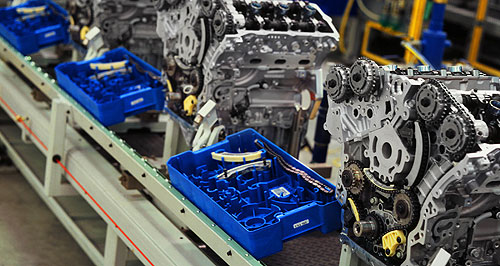Make / Model Search
News - HoldenHolden V6 engine plant quandaryOn the go-slow: Workers assemble a SIDI V6 at Holden's Port Melbourne engine plant. Demand for smaller, thriftier cars set to put future of Holden V6 plant up for grabs20 Feb 2012 DIMINISHING demand for V6 engines in a world heading towards smaller and more fuel efficient cars will ultimately require General Motors to consider another direction for its Holden Engine Operations Global V6 plant at Port Melbourne, according to Holden chairman and managing director Mike Devereux. “It is a discussion we will have to have,” Mr Devereux said at the Melbourne launch of the new dedicated LPG V6 Commodore and Caprice range today when asked by GoAuto about the factory’s long-term future. Although Mr Devereux said the plant would continue to produce V6 engines for locally made cars and for export for some years to come, it was inconceivable that all the V6 engines currently produced by GM’s four V6 plants around the world would be required in future. Mr Devereux declined to be drawn on whether the plant could be converted to another, more fuel-efficient option such as four-cylinder engines for the locally assembled – and successful – Cruze small car. Asked if the future of the engine plant had been included in current negotiations with the federal government over a proposed co-investment plan for the local manufacturer to ensure GM investment in future Holden products in Australia, Mr Devereux said: “They are on different time frames.” He said motor vehicle platform planning took much longer than powertrain planning, and could be considered completely separate. The Holden engine plant last year produced about 100,000 V6 engines, with about half destined for export markets in China, South Korea and the United States. The production volume remained steady on 2010 volumes, when 98,146 engines came off the production line. However, at that rate, the $400 million plant is running at only 40 per cent of its 240,000-units a year capacity that it was designed for when it opened in 2003. Although the plant has partly recovered from a major dip in production due to the global financial crisis, when it made just 62,686 engines, the recovery has been stalled by falling large car sales in Australia, a drop in exports of completely built up cars from Elizabeth to markets such as the Middle East and North America, the demise of a number of niche export markets for engines and the rising Australian dollar.  Last year, Australian sales of Holden’s mostly V6-powered VE/WM large-car range – including Commodore sedans, Utes, Sportwagons and Caprice luxury sedans – slipped almost 12 per cent to 51,998 vehicles, while exports of locally assembled Holden cars to the Middle East and the United States hit rock-bottom, largely due to unfavourable exchange rates. Last year, Australian sales of Holden’s mostly V6-powered VE/WM large-car range – including Commodore sedans, Utes, Sportwagons and Caprice luxury sedans – slipped almost 12 per cent to 51,998 vehicles, while exports of locally assembled Holden cars to the Middle East and the United States hit rock-bottom, largely due to unfavourable exchange rates.Handy niche export business of high-performance turbocharged V6 engines to Saab, Alfa Romeo, Cadillac and Opel has withered or simply not materialised as planned. In the case of Saab, the former GM subsidiary plunged into bankruptcy, ending all Saab production, including the 2.8-litre turbo V6-powered Saab 9-5 made in Sweden and Saab 9-4X SUV built in Mexico – both of which used Holden engines. Alfa, which sourced the Holden turbo engine in V6 for its 159, Brera and Spider, has dropped it in favour of a Pentastar V6 from Chrysler for the new Giulia, under parent company Fiat’s tie-up with the American manufacturer. Even GM sister company Cadillac axed the Holden turbo engine from the premium version of its SRX luxury medium SUV – made on the same Mexican production line as the related Saab 9-4X – due to slow sales. In the latest blow to the V6 plant, GM has elected to go with an all-diesel engine line-up for its new-generation 2012 Colorado built by GM Thailand, ending the run of the Holden-built 3.6-litre Alloytec V6 in Colorado’s 4x2 single-cab, space-cab and crew-cab utes as an alternative to the popular 3.0-litre Isuzu-sourced diesel and less popular 2.4-litre petrol four-cylinder (which has already been discontinued). Sales of the V6 variant in the current Colorado range – sold in Australia in both petrol and dual-fuel LPG types – have dwindled in recent years, to the point where 93 per cent of all Colorados shifted by Holden dealers in 2011 were diesel. Now, Holden has announced that the only engine choice will be between a pair of new GM-sourced four-cylinder diesels – an entry-level 110kW 2.5-litre and premium 132kW 2.8-litre. The two biggest V6 export markets remain South Korea, where the 3.0-litre SIDI V6 is fitted to top-end Captivas built under Chevrolet and Holden badges by GM Korea for global markets, and China, where a successful GM Buick minivan gets the Holden V6 engine. As well, Australia is exported some 3.6-litre V6 engines to the US, where that particular variant is out of production. In 2009, Australia’s then-industry minister Kim Carr announced that Holden engine exports to China would grow 400 per cent, from about 6000 units a year to 20,000 a year, with the Holden Engine Operations factory returning to two shifts to accommodate it. Mr Devereux recently conceded the pressures on the engine plant when he said it had been shedding workers by natural attrition.  Read more4th of January 2011  Cadillac puts brakes on Holden turbo V6Slow sales scuttle turbo Cadillac SRX – and part of Holden's V6 export program7th of December 2010  LPG for ColoradoHolden’s Colorado one-tonner is now available with the Commodore’s LPG V6 |
Click to shareHolden articlesResearch Holden Motor industry news |











Facebook Twitter Instagram